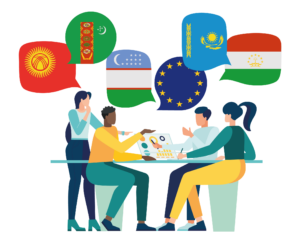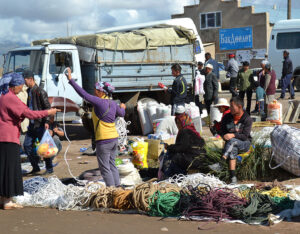The EU-Central Asia Human Rights Dialogues: Making a Difference?

Introduction
Structured human rights dialogues (HRDs) were introduced as part of the broader EU democratisation policy towards Central Asian states after the adoption of the ‘EU and Central Asia: Strategy for a New Partnership’ in June 2007. The dialogues are conducted on a bilateral basis with each of the five Central Asian republics. As with the human rights dialogues established by the EU with a number of other countries, the HRDs with the Central Asian states are designed to ‘discuss questions of mutual interest and enhance cooperation on human rights, inter alia in multilateral arena such as the United Nations and the OSCE’ as well as to ‘raise the concerns felt by the EU on human rights in the countries concerned, gather information and launch initiatives to improve the relevant human rights situation.’(1)
The structured HRDs include formal meetings of (usually senior and/or mid-level) human rights officials of the European Commission,(2) Council Secretariat,(3) and the EU Presidency(4) with representatives of relevant departments (5) of the Central Asian republics. The meetings should be held once a year, alternately in Brussels and in the countries involved. In addition, the dialogues seek to involve human rights activists, NGO members, and academia representatives from both Europe and Central Asia through civil society seminars held in between the official HRD sessions and funded under the European Instrument for Democracy and Human Rights (EIDHR).
By the end of 2010, four official rounds of dialogues had been conducted with Uzbekistan, three rounds with Kazakhstan and Turkmenistan, and two rounds with Kyrgyzstan and Tajikistan.(6) Over 2008-2009, one civil society seminar was organised in each of the Central Asian republics, except for Turkmenistan, and a regional seminar with participants from all the five states was held in Brussels in 2010.
This policy brief reviews and evaluates the performance of the dialogues to date, paying specific attention to the shortcomings of the existing practices, and provides recommendations for what could be improved with regard to HRD planning and procedures.
Official dialogue sessions
The EU-Uzbekistan HRD held within the framework of the Subcommittee on Justice and Home Affairs, Human Rights and Related Issues, was the first one to be officially established in 2007 after the preparatory negotiations, which had started in 2006 (before the adoption of the ‘Strategy for a New Partnership’), in response to the Andijan May 2005 events. The launch of the structured HRDs between the EU and the other four republics followed in 2008 with the first official sessions conducted with Turkmenistan in June and with Kazakhstan, Kyrgyzstan and Tajikistan in October 2008.6
The official sessions include several hours of intensive, focused discussions on human rights issues. The adoption of an agenda for each round of HRD follows a standard procedure of preliminary exchange of notes between the European Commission’s Delegation on the ground and the respective ministry of foreign affairs on the issues to be possibly discussed during the official dialogue. The discussions usually cover the general human rights situation and specific developments in the country concerned. At times, European experts offer thematic presentations on the ‘best practices’ in the EU (e.g. abolition of the death penalty or ‘habeas corpus’), and representatives of the respective Central Asian government present (follow-up) reports on the recent HR-related developments in the country, which are subsequently discussed in an open debate.
In addition to the discussions on the general human rights situation, the EU normally raises a number of individual cases with regard to protection of human rights defenders against arbitrary treatment by the authorities in the countries concerned. A list with the names of individuals(7) currently detained or who have their rights limited on politically-motivated grounds is handed over by the European representatives to the respective Central Asian government officials with the expectation that the cases will be followed-up. Apart from that, human rights developments in UN forums (with the focus on the Universal Periodic Review) and in the Organisation for Security and Co-operation in Europe (OSCE) are discussed during the HRD rounds. The Uzbek government has only agreed to participate in the dialogue if it is based on the principle of equality thus criticising the European human rights track-record. With the other Central Asian republics this is normally not the case.
Civil society involvement
In accordance with the EU general guidelines on human rights dialogues, providing for a possibility of involvement of European and third country’s civil society,(8) the Commission organises civil society seminars in between the official dialogue sessions. At the seminars human rights activists, NGO members and academia representatives from the Central Asian republics meet with their European colleagues in the presence of EU and respective national government officials (as observers) to discuss specific areas of concern and prepare detailed recommendations for the official dialogue. Procedurally, the seminars present a mixture of plenary speeches, panel discussions and workshop sessions.
Initially, the issues in focus of the civil society seminars were supposed to be country-specific. Thus, the topic of the first EU-Uzbek seminar on 2-3 October 2008 was ‘Liberalisation of mass media – an important component of the democratisation of society’. By comparison, ‘Co-operation to protect and promote children’s and prisoners’ rights’ was discussed during the first civil society seminar with Kyrgyzstan on 5-6 March 2009. The topics of the seminars are usually proposed by the European Commission, not by the participating civil society representatives, and are negotiated with the respective Central Asian government, often a lengthy and technocratic process.
Similarly, the potential participants are suggested by the Commission, which offers a list of European civil society organisations (CSOs) and experts to take part in the seminars, and the respective Central Asian government, which provides a list of local civil society representatives.
Originally, the idea was to organise civil society seminars annually with all five countries on a bilateral basis. Yet, in the course of implementation, several changes have been introduced. After the first seminar round with Uzbekistan in 2008, bilateral seminars were organised with Kyrgyzstan, Kazakhstan and Tajikistan in March, June and July 2009 respectively. However, there was no civil society seminar with Uzbekistan in 2009 and no seminars with Turkmenistan in 2008-2009. The reason for this lies in the failure of the first civil society seminar held in Uzbekistan, which turned out to be a negative experience for both Uzbek and European sides. The participating European (mainly Brussels-based) human rights NGOs expressed harsh critique towards the human rights situation particularly with regard to the lack of freedom for mass media in Uzbekistan. The Uzbek side was represented by government operated NGOs, which responded by presenting essentially positive statistics and progressive developments in the country. This left no room for a serious, constructive discussion and eventually led to the cancellation of the seminar with Uzbekistan in 2009.
This experience was taken into account by the Commission when organising the subsequent rounds of seminars in Central Asia with regard to both topics proposed for discussion and potential participants. Thus, considering the absence of state-independent CSOs in Turkmenistan, a decision was taken not to organise a civil society seminar in this country, since it would have led to the same (negative) results as in Uzbekistan.
Another conclusion drawn from the experience of the first civil society seminar was the switch to a regional approach in the EU relation with the Central Asian non-governmental actors. Thus, there were no separate seminar rounds in 2010. Instead, a regional ‘EU-Central Asia Civil Seminar on Women’s Rights’ was organised. This year, one of the three scheduled civil society seminars will be held in the same regional format.
The European Commission also organises ‘closed’ pre- and post-dialogue briefings with the European (primarily Brussels-based) NGOs at home with the purpose of information sharing and exchange. The NGOs are consulted with regard to the issues to be discussed during the official dialogue rounds and civil society seminars, availability of state-independent NGOs in the Central Asian republics (e.g. local partners of the European NGOs), and the ongoing cases of political prisoners in the respective countries.
Interactions between the European Commission and Central Asian civil society actors are rather rare and ad hoc. There are no regular consultations comparable with the briefings in Brussels. Yet, there are attempts to organise meetings with independent civil society representatives shortly before the official dialogue rounds (e.g. to follow-up on the recommendations developed during the civil society seminars). Such meetings are usually prepared by the EU presence on the ground.(9) Thus, before the second round of the official HRD with Kyrgyzstan in 2009, a video-conference was held with Kyrgyz and international NGOs representatives. In the case of Uzbekistan and Turkmenistan, it is impossible to organise such conferences or meetings with independent civil society actors.(10)
Evaluating the dialogues
Evaluating human rights dialogues is difficult. Despite the EU’s own guidelines for HRDs, stating that ‘[a]ny decision to open a human rights dialogue will first require the defining of the practical aims which the Union seeks to achieve by entering into dialogue with the country concerned’,(11) no specific objectives of the EU HRDs with the Central Asian republics are pronounced. Apart from the very general aims formulated in the European Commission’s Factsheet on EU Human Rights Dialogues in Central Asia,(12) no public EU document contains more specific objectives or benchmarks. The Commission prepares internal (unpublished) priority papers for each Central Asian HRD partner, which encloses more detailed expectations of what can be achieved within each dialogue round. Yet, no benchmarks are included in these internal documents either. Conversations with EU officials have revealed reluctance toward setting public benchmarks, because it is perceived as an alienating approach. To highlight this reference is commonly made to the case of the EU-Iran human rights dialogue, for which the EU formulated public benchmarks in 2004, after which the dialogue eventually froze.
The absence of clear objectives is problematic, considering the EU guidelines for HRDs that call for ‘assessing the situation [the human rights situation in the country concerned] in relation to the objectives which the Union set itself before the start of the dialogue’ and examining ‘how much added value has been provided by the dialogue’.(13) According to the guidelines, such assessment may be conducted by the Presidency and the Council Secretariat, involving civil society, with the progress regularly discussed by the Working Party on Human Rights (COHOM) together with the geographical working parties, the Working Party on Development Cooperation (CODEV) and the Committee on measures for the development and consolidation of democracy and the rule of law, and for the respect of human rights and fundamental freedoms.
As interviews with the EU officials have revealed, the internal discussions in fact take place on a regular basis as part of preparation/follow-up for dialogues. Yet, they are limited to the COHOM and the relevant geographical working party – COEST. No extensive study on the implementation and effects of the HRDs with the Central Asian countries has been conducted (or is planned) so far. The absence of clearly defined objectives and assessment mechanisms creates an impression of poor strategic planning of the human rights dialogues.
The recommendations elaborated during the civil society seminars are commonly presented and followed up by the EU and Central Asian representatives during the official HRD rounds. During the EU-Kyrgyzstan 2009 dialogue session, the Kyrgyz side proposed to prepare a national action plan based on the civil society recommendations in the sphere of children’s and prisoners’ rights. However, according to the Council officials, as there had been no further HRD session with Kyrgyzstan since October 2009, it was impossible for them to follow-up on the development of the action plan. Although implementation of the civil society recommendations are supposed to be monitored by the EU delegations on the ground and (formerly) by the relevant officials of the Commission’s DG RELEX, apparently there has been no functioning mechanism for distributing and coordinating this information within the EU.
Specific cases of HR violations are raised and controversial issues are addressed directly in the dialogues during the official HRD rounds, which are held behind the closed doors. In the case of the civil society seminars, which are held in a more open-for-public setting, there is a general tendency towards opting for ‘softer’, less controversial issues, especially after the failure of the first seminar with Uzbekistan. This is explained firstly by the impossibility of discussing ‘hard’ cases of human rights violations with Central Asian civil society representatives without putting them at risk, and secondly by the necessity to open up the general discussion first to be able to get to the ‘harder’ issues later, as insisting on ‘hard’ human rights-related issues from the very beginning might ‘kill’ the dialogue. This confirms that the EU has learnt its lessons after the first civil society seminar with regard to the possible negative consequences of politicising human rights in a public setting.
The lesson-learning has, however, not accounted for the potential side effects of the human rights dialogues themselves. Participating in the HRDs, Central Asian governments might be unwilling to discuss human rights issues in other formats, e.g. within the framework of political dialogue with the EU or its member states. The same is true for the EU member state officials avoiding human rights questions during their security or trade related meetings with the Central Asian government representatives, which is justified by the existence of the HRD as a specific platform for raising human rights concerns. This results in severe policy inconsistencies within the EU and undermines its credibility. Another danger is that Central Asian governments may use the HRD to claim their commitment to human rights on a rhetorical level without introducing actual improvements. This situation should not satisfy the European Union.
These and other shortcomings of the HRD process need to be addressed, for instance through considering the following recommendations:
- A more strategic approach towards HRDs with the Central Asian republics needs to be developed, including specifying objectives for each year’s dialogue round, which should be publicly available and formulated as explicit outcome expectations. Setting conditions that need to be fulfilled for the dialogues to proceed would not be recommendable though, as this would be perceived by Central Asian officials as an intrusive or even hostile measure.
- Human rights dialogues are by no means an adequate instrument for exerting pressure through conditionality or benchmarking, especially in the Central Asian context, as the leverage of the EU is not sufficient for this in the region. The purpose of the HRDs is rather information exchange and confidence building with the final aim of the human rights norms diffusion. An approach labelled ‘soft but persistent insistence’ would be thus more apt. Such an approach involves first focussing on country specific issues that are perceived as less sensitive and are more feasible to achieve a change. This would allow establishing a level of credibility between the EU and Central Asian governments, which would enable opening up more sensitive/harder issues at a later stage.
- Credibility-building implies, in turn, the need for an equality-based approach, i.e. symmetrical dialogue, focusing not only on the human rights situations in the Central Asian republics, but also on HR developments in the EU Member States, including problematic issues and how they have been dealt with so far by the EU and its Member States. For this, a pool of relevant European experts could be created, who would be brought in for consultations during the official HRD sessions. This approach might also bring the Central Asian states closer to the Council of Europe, a process that has already started in the case of Kazakhstan.
- A more enhanced and systematic engagement with Central Asian civil society representatives is needed within and beyond the HRD process. Yet, this engagement should assume a careful differentiated approach, taking account of the distinct developments in the civil society sectors of the five countries. Thus, in Kazakhstan, Kyrgyzstan and Tajikistan, where the first round of civil society seminars resulted in a range of constructive recommendations, a more effective follow-up mechanism for monitoring of the progress on the recommendations should be established. It must be also ensured that specific suggestions for the EU, including seminars-related organisational issues, as inputs from civil society are accounted for.
- A strategic approach towards human rights dialogues implies a comprehensive assessment of what has been achieved through the HRDs since their launch. It would be recommendable to initiate a research exercise, including a context study of Central Asian states (to reveal the local conditions for potential success of the dialogues) and the HRDs’ impact to date, but also a comparative study of the HRDs’ effects in other (non-Central Asian) states. This would serve to determine the future approach, specify the objectives and introduce necessary changes to the HRD procedures. Such a research project could involve both European and Central Asian experts, which would serve the purpose of enhancing the participatory approach to evaluation and strengthen the dialogue between the European and Central Asian research communities.
- Finally, in order to avoid policy inconsistencies within the EU, a functional mechanism needs to be established to coordinate the EU efforts within the structured HRDs and the other forms of political dialogue, including bilateral dialogues between the member states and the Central Asian republics. This mechanism could operate at the Foreign Affairs Council level ensuring the member states’ endorsement of the HRDs’ objectives and their ownership of the process.
- European Union Factsheet: EU Human Rights Dialogues in Central Asia, http://www.eeas.europa.eu/central_asia/docs/factsheet_hr_dialogue_en.pdf
- Before the Lisbon Treaty’s entry into force, representatives of the DG RELEX, Human Rights Unit.
- E.g. at the level of the Head of the Human Rights Unit of the Council Secretariat.
- Before the Lisbon Treaty, with the incumbent presidency in the position of chair.
- Usually ministers or deputy ministers of the interior and justice, but representatives of law enforcement agencies, general prosecutor’s offices and ombudspersons are also occasionally present.
- Notably, in 2005-2007, an ad hoc EU-Turkmenistan human rights dialogue was undertaken in the margins of the Joint Committee meeting under the Trade and Cooperation Agreement.
- E.g. human rights defenders, activists, journalists, and their family members.
- EU Guidelines on Human Rights Dialogues with Third Countries, http://www.consilium.europa.eu/uedocs/cmsUpload/16526.en08.pdf
- In the case of Kyrgyzstan and Tajikistan, the European Commission’s delegation offices (subordinate to the delegation in Kazakhstan), have been upgraded to full-fledged embassies. As there are still no EU embassies in Uzbekistan and Turkmenistan, the Europa Houses or the individual member state embassies are the only European representations there.
- The unofficial contacts with Uzbek and Turkmen human rights activists are either supported through member state embassies and European NGOs offices/partners on the ground or through members of diaspora.
- EU Guidelines on Human Rights Dialogues with Third Countries, http://www.consilium.europa.eu/uedocs/cmsUpload/16526.en08.pdf
- European Union Factsheet: EU Human Rights Dialogues in Central Asia, http://www.eeas.europa.eu/central_asia/docs/factsheet_hr_dialogue_en.pdf
- EU Guidelines on Human Rights Dialogues with Third Countries, http://www.consilium.europa.eu/uedocs/cmsUpload/16526.en08.pdf



![shutterstock_1240181551 [Omgezet]](https://eucentralasia.eu/wp-content/uploads/2024/10/shutterstock_1240181551-Omgezet-300x248.jpg)



